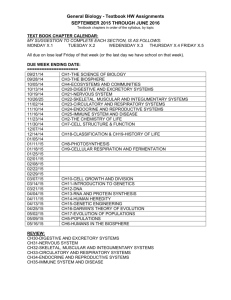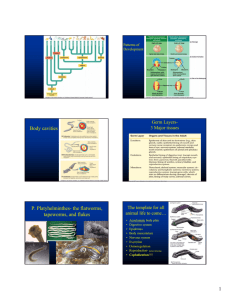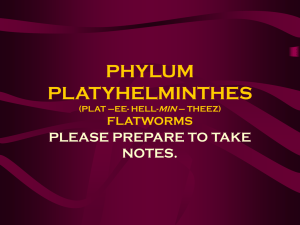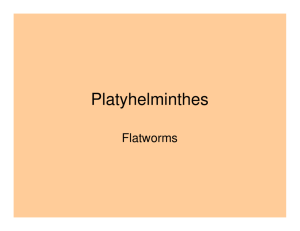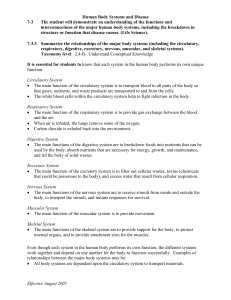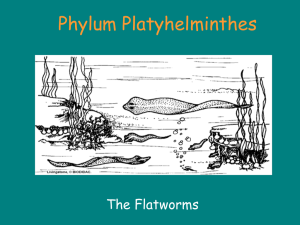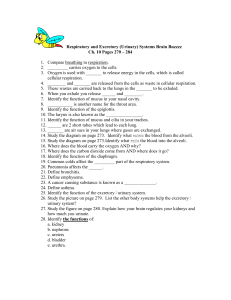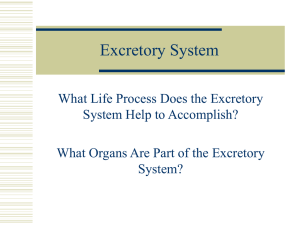PHYLUM PLATYHELMINTHES Class Turbellaria
advertisement
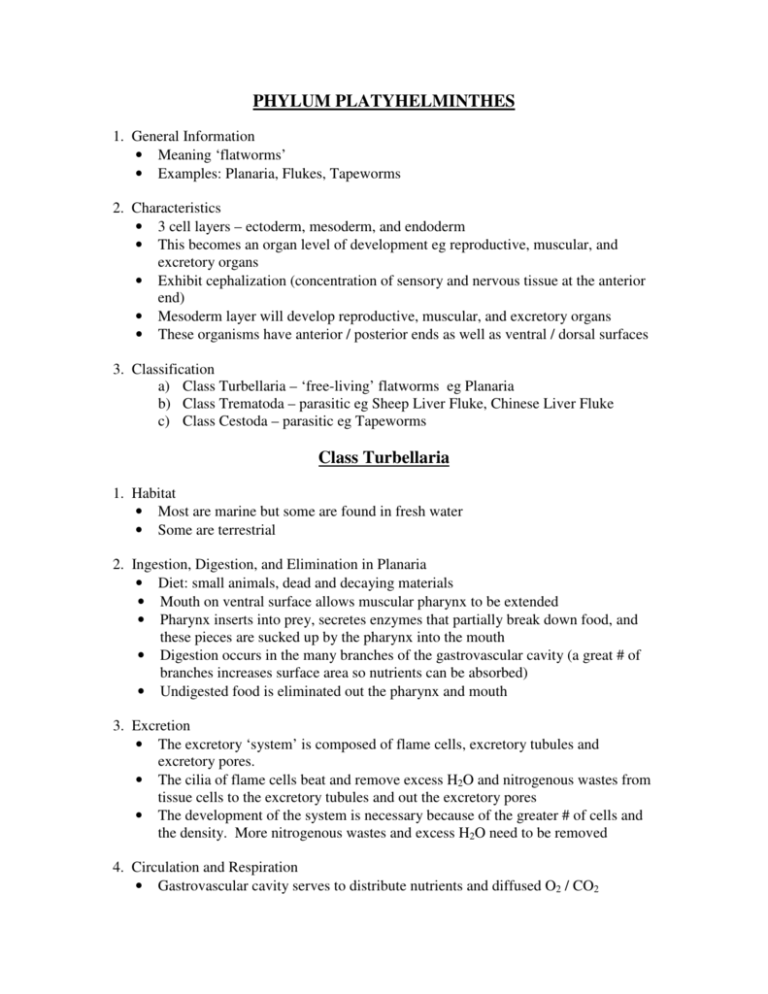
PHYLUM PLATYHELMINTHES 1. General Information • Meaning ‘flatworms’ • Examples: Planaria, Flukes, Tapeworms 2. Characteristics • 3 cell layers – ectoderm, mesoderm, and endoderm • This becomes an organ level of development eg reproductive, muscular, and excretory organs • Exhibit cephalization (concentration of sensory and nervous tissue at the anterior end) • Mesoderm layer will develop reproductive, muscular, and excretory organs • These organisms have anterior / posterior ends as well as ventral / dorsal surfaces 3. Classification a) Class Turbellaria – ‘free-living’ flatworms eg Planaria b) Class Trematoda – parasitic eg Sheep Liver Fluke, Chinese Liver Fluke c) Class Cestoda – parasitic eg Tapeworms Class Turbellaria 1. Habitat • Most are marine but some are found in fresh water • Some are terrestrial 2. Ingestion, Digestion, and Elimination in Planaria • Diet: small animals, dead and decaying materials • Mouth on ventral surface allows muscular pharynx to be extended • Pharynx inserts into prey, secretes enzymes that partially break down food, and these pieces are sucked up by the pharynx into the mouth • Digestion occurs in the many branches of the gastrovascular cavity (a great # of branches increases surface area so nutrients can be absorbed) • Undigested food is eliminated out the pharynx and mouth 3. Excretion • The excretory ‘system’ is composed of flame cells, excretory tubules and excretory pores. • The cilia of flame cells beat and remove excess H2O and nitrogenous wastes from tissue cells to the excretory tubules and out the excretory pores • The development of the system is necessary because of the greater # of cells and the density. More nitrogenous wastes and excess H2O need to be removed 4. Circulation and Respiration • Gastrovascular cavity serves to distribute nutrients and diffused O2 / CO2 5. Nervous System • See handout and also p454 • Exhibits cephalization, contains knots of nerve tissue at the anterior end • Ganglia attaches to a pair of ventral nerve cords • The anterior end contains eye spots that are sensitive to light and pointed lobes that are sensitive to touch. 6. Muscular System • 2 layers of muscle tissue below the ectoderm layer • The longitudinal and circular layers of muscle tissue allow the planaria to contract, twist, turn, and are stimulated by the nervous system to allow movement 7. Reproduction a) Asexual: binary fission • They regenerate any missing parts b) Sexual: hermaphrodites trade sperm with each other • Fertilization is internal zygote is released into H2O CLASS TREMATODA * * * * Parasitic flukes eg. sheep liver flukes, blood flukes leaf-shaped, they are dorsally/ventrally, flattened thick cuticle to prevent digestion by the host have 1 or more suckers to hold onto the host DIGESTION * muscular pharynx sucks up blood from tissue and takes it through the mouth into the 2 sided GVC. The GVC has many ranches to increase the surface area for digestion and absorption of nutrients CIRCULATION * GVC also circulates nutrients and CO2 / O2 gases for respiration ADDITIONAL CHARACTERISTICS * nervous / muscular systems are greatly reduced or absent * they produce 1000’s of eggs since very few survive * they are hermaphrodites with a complex life cycle involving more than one host. * * * * * * CLASS CESTODA parasitic tapeworms live in humans, dogs, cats, cows, elk, moose, bears…. They are long & dorsally/ventrally flattened Have a tough integument to prevent being digested by host Have a scolex (head) surrounded by suckers/hooks to attach to the host Excretory, nervous, muscular systems are reduced or absent * Digestive system is absent as they are bathed in nutrients and nutrients enter by diffusion * Reproductive organs are found in proglottids (segments) * They are hermaphrodites and can produce 1000’s of eggs each PARASITIC ADAPTATIONS OF TAPEWORMS AND FLUKES * have suckers & hooks so that they can attach to the host * have a tough tegument to prevent being digested by the host (tapeworm) or they have a cuticle (flukes) * absent or reduced digestive, circulatory, and muscular systems as they are parasites living inside a host * produce 10’s to 1000’s of eggs to ensure survival * have a complex lifecycle which involves several hosts and different environmental conditions which makes prevention difficult.
